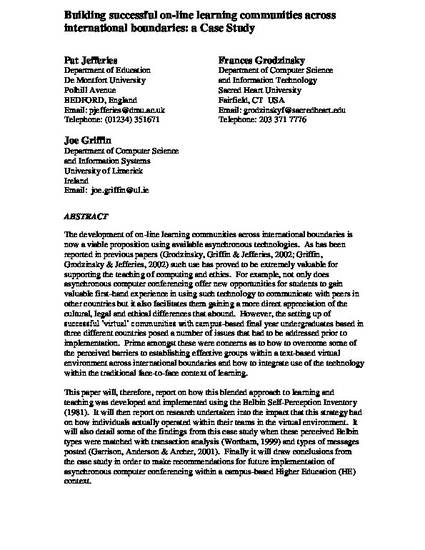
The development of on-line learning communities across international boundaries is now a viable proposition using available asynchronous technologies. As has been reported in previous papers (Grodzinsky, Griffin & Jefferies, 2002; Griffin, Grodzinsky & Jefferies, 2002) such use has proved to be extremely valuable for supporting the teaching of computing and ethics. For example, not only does asynchronous computer conferencing offer new opportunities for students to gain valuable first-hand experience in using such technology to communicate with peers in other countries but it also facilitates them gaining a more direct appreciation of the cultural, legal and ethical differences that abound. However, the setting up of successful ‘virtual’ communities with campus-based final year undergraduates based in three different countries posed a number of issues that had to be addressed prior to implementation. Prime amongst these were concerns as to how to overcome some of the perceived barriers to establishing effective groups within a text-based virtual environment across international boundaries and how to integrate use of the technology within the traditional face-to-face context of learning. This paper will, therefore, report on how this blended approach to learning and teaching was developed and implemented using the Belbin Self-Perception Inventory (1981). It will then report on research undertaken into the impact that this strategy had on how individuals actually operated within their teams in the virtual environment. It will also detail some of the findings from this case study when these perceived Belbin types were matched with transaction analysis (Wortham, 1999) and types of messages posted (Garrison, Anderson & Archer, 2001). Finally it will draw conclusions from the case study in order to make recommendations for future implementation of asynchronous computer conferencing within a campus-based Higher Education (HE) context.
Available at: http://works.bepress.com/frances_grodzinsky/14/

Originally published:
Jefferies, P., Grodzinsky.,F., Griffin, J. “Building successful on-line learning communities across international boundaries: A case study.” Ethicomp Proceedings, 2004, University of the Aegean, Syros Greece.